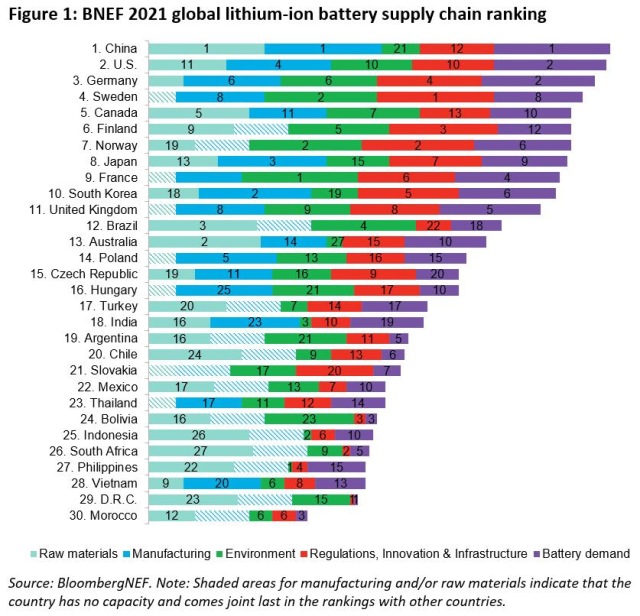China has dominated BloombergNEF’s (BNEF) global lithium-ion battery supply chain ranking in both 2021 and its projection for 2026.
China hosts 80 percent of all battery cell manufacturing capacity today, with capacity expected to more than double to over two terawatt-hours, enough capacity for more than 20 million electric vehicles (EVs), in the next five years.
The U.S. moves up the ranking to come second in both 2021 and 2026. The U.S. has the second largest EV market globally, after China. Tesla and Asian cell manufacturers continue to make significant investments in the country.
James Frith, BNEF’s head of energy storage, said: “The U.S. has many of the ingredients needed to foster a domestic lithium-ion battery value chain, but in the past, individual companies like Tesla have had to forge a path by themselves.”
 European countries are also rising up the ranking as passenger EV sales steadily grow, attracting more investment in the supply chain. Nordic countries are increasingly important to Europe’s efforts, as their low-carbon power supplies make them attractive to environmentally conscious companies. Finland will soon be home to one of the world’s largest refineries for nickel and cobalt sulfate, both key ingredients for use in EV batteries.
European countries are also rising up the ranking as passenger EV sales steadily grow, attracting more investment in the supply chain. Nordic countries are increasingly important to Europe’s efforts, as their low-carbon power supplies make them attractive to environmentally conscious companies. Finland will soon be home to one of the world’s largest refineries for nickel and cobalt sulfate, both key ingredients for use in EV batteries.
Battery material producers Umicore and BASF have also both invested in the country. Later in 2021, batteries are expected to roll off the production line from the first European-owned gigawatt-hour scale cell plant, when Northvolt commissions its Swedish facility.
While European countries are ranked individually in the BNEF report, the ability for tariff-free trade between countries in Europe means that, as a continent, its battery demand is second only to China. If ranking Europe as a whole, it comes first in our ranking in 2021 and 2026.
South Korea and Japan rank lower in 2021 compared to last year, but Japan is on track to rise up through the ranking to take third place in 2026, as domestic demand increases alongside continued investments in materials refining and component production.
Most resource-rich countries rank lower in the supply chain ranking as they generally lack a domestic battery supply chain and battery demand. However, some of these countries, such as Australia and Finland, have managed to move up the rankings.
BNEF ranks 30 leading countries across the lithium-ion battery supply chain based on 41 metrics across five key themes: availability and supply of key raw materials; manufacturing of battery cells and components; local demand for electric vehicles and energy storage; and policy and environmental considerations.

